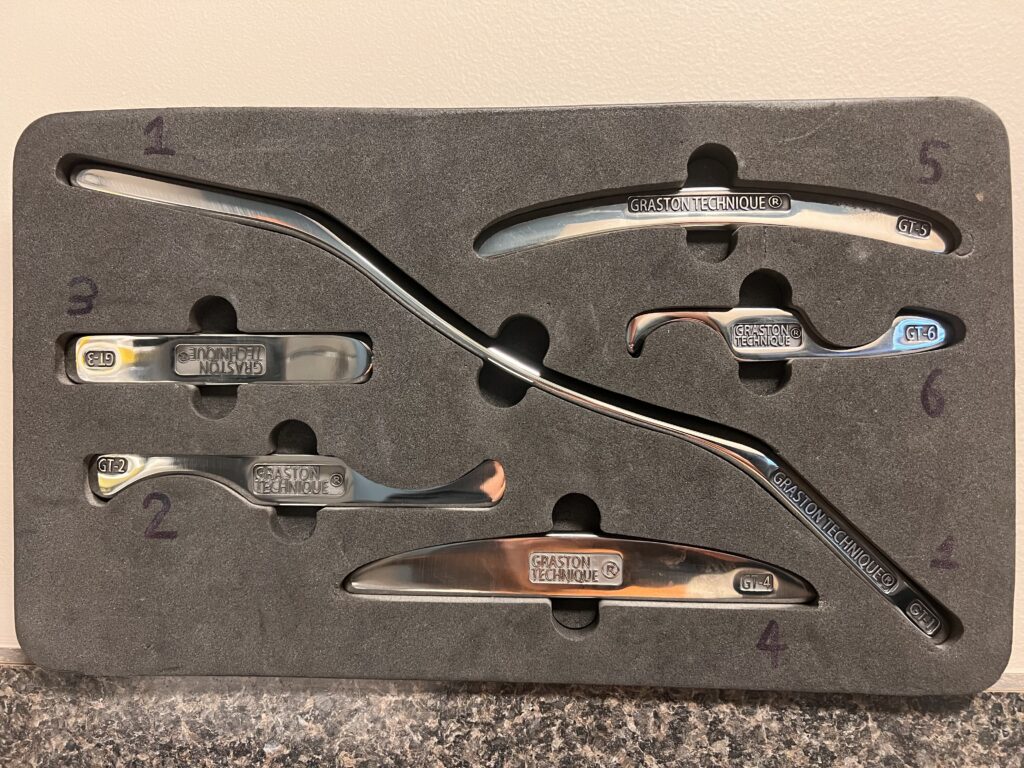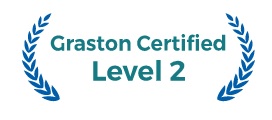What is Instrument Assisted Soft-Tissue Mobilization?

It’s a term used for instruments or tools used by a provider to move or break-down adhesions between layers of soft tissue. The Graston Technique® (discussed below), is a restricted trade-name for a specific tool set and technique training. Soft Tissue is the term for various layers of skin, fat, fascia, blood vessels, nerves, tendons, ligaments and muscle that connect and support our bones and organs. It gives us our shape, our structure and allows bones to move on each other. that gives us our shape and helps support and move our structures. We primarily use the tools to treat contractions or adhesions in the myofascia, muscle, tendons and ligaments. Our office utilizes the Graston Technique® to provide a manual approach to breaking down restrictions in the soft-tissue surrounding joints in the body. These instruments allow us to apply more specific force to the treatment area without damaging the provider’s body, especially hands. Using instruments or tools to manipulate the soft-tissues of the body has been around since the Paleolithic era and recorded in literature during the Ming Dynasty (1368-1644).

What Is The Graston Technique?
The Graston Technique® was conceived in 1994 when an amateur athlete machined his own set of tools to help his soft-tissue injuries sustained during water-skiing. Collaborating with local hospitals in Indiana, the instruments were refined and a technique of use was developed. Today, the Graston Technique® has evolved into not only tools but a technique used by athletic trainers, physical therapists, physiotherapists and chiropractors. Graston Technique® requires it’s clinicians to undergo rigorous training and adhere to clinical principles to perform the proper treatment. They have many published studies and resources available to demonstrate the effectiveness of the Graston Technique® in treating soft-tissue injuries.

Using the Graston® instruments in conjunction with your care will speed your recovery, known effects are reduction in fascial restrictions, improved circulation and a change in sensory reception at the site of treatment.
Some of the most commonly treated conditions with Graston Technique® include;
- Ankle Pain (Achilles Tendinosis/itis)
- Wrist Pain (Carpal Tunnel Syndrome)
- Neck Pain (Cervical Sprain/Strain)
- Fibromyalgia
- Hamstring Injuries
- Hip Pain
- IT Band (Iliotibial Band)
- Tennis Elbow (Lateral Epicondylosis/itis)
- Back Pain (Lumbar Sprain/Strain)
- Golfer’s Elbow (Medial Epicondylosis/itis)
- Knee Pain (Patellofemoral Disorders)
- Heel Pain (Plantar Fasciitis)
- Shoulder Pain (Rotator Cuff Tendinosis/itis)
- Scar Tissue
- Trigger Finger
- Women’s Health (Post-Mastectomy and Caesarean Scarring)
More information regarding the Graston Technique® may be found on their website listed below.
The Graston Technique® emphasizes that the therapy be minimally invasive, with minimal pain. There are guidelines in place to minimize bruising and pain after the treatment. Instrument Assisted Soft-Tissue Mobilization rendered by an untrained provider may lead to severe bruising and other unwanted outcomes. We do our best to determine if you are a candidate for this technique and deliver the best result with minimal discomfort.
Resources:
Graston Technique® Website https://grastontechnique.com/patients/#
The History of Gua-Sha https://www.theskingames.com/gua-sha-the-history-benefits-and-side-effects/#:~:text=Although%2C%20the%20period%20of%20the,back%20to%20the%20Paleolithic%20Age.
Effective applications and outcomes of Graston soft tissue technique : a literature review https://bridges.searchmobius.org/record=b1806042~S6
